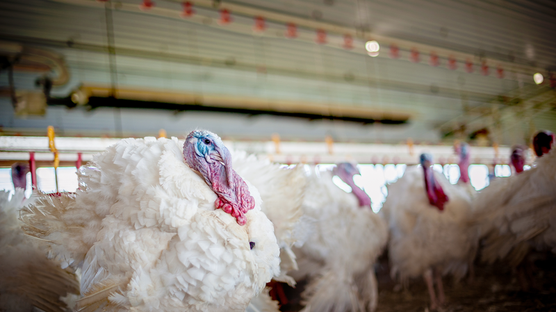
Published on March 15, 2024
Understanding and Managing Blackhead Disease in Turkeys
Blackhead disease, also known as histomoniasis, is a significant concern in the turkey industry due to its potential impact on flock health and productivity. For turkey growers directly impacted by this health challenge, this article will help answer your questions on
- What are the symptoms of blackhead disease in turkeys?
- How is it transmitted?
- What are some biosecurity measures to manage and prevent outbreaks?
What is Blackhead Disease?
Affected birds may exhibit vulture-like appearance due to the chronic wasting nature of the disease. They will have empty crops and display weakness from the decrease in absorption of nutrients and energy. They also may have drooping of their head and wings, have prolonged standing, closed eyes, ruffled feathers, emaciation, and sulfur-colored feces. Upon examination, the tell-tale signs of blackhead disease are the thickening of the cecal wall, often with cecal core formation, and splotches on the liver. Depending on the rate of transmission in your flock, farmers may see mortality ranging from 5-100%. Though Blackhead disease occurs in chickens , it often is much more devastating for turkey operations.
How Does Blackhead Disease Spread?
Blackhead disease is caused by a parasite called histomonas meleagridis. This parasite can come to your turkeys in two ways – either from direct contact with feces that are contaminated with histomonas meleagridis or by coming into contact with the eggs of the heterakis galinarum worm. The worms consume the parasite and shed it in their eggs. Because poultry usually have both the worms and intestinal parasites together at the same time - the infected birds are depositing both long and short term infection agents into the environment with every defecation via the heterakis galinarum eggs and histomonas meleagridis directly.
When the bird defecates, these eggs containing the histomonas parasite are shed into the environment, which, upon reingestion by certain poultry species even years into the future, can lead to blackhead disease. These eggs can be very durable and may persist in the environment for up to 10 years, posing a near constant threat. Mechanical vectors, such as boots, tires, or even insects can act as couriers of these contaminated eggs from the ground around your facility and introduce them into your barns.
Once Blackhead disease is in the barn, it can be passed from bird to bird through contaminated cecal droppings that are eaten or taken up through a process called cloaca drinking.
Managing Outbreaks
In the event of an outbreak, one strategy is to implement physical barriers within the turkey house to allow the disease to take its course of action. This strategy aims to limit the spread of the disease among the whole flock. Once birds stop showing signs of the disease barriers can be removed and routine cleaning should be sufficient, as the parasite has limited viability in the environment.
Another option is to aggressively cull infected birds twice a day removing any infected birds to eliminate the spread from bird to bird via cecal dropping consumption.
Biosecurity Measures
Although the use of barriers is a good practical solution, the most effective way to prevent blackhead is to protect the environment from the pathogen before it can come into the barn. A robust biosecurity program to identify and analyze potential entry points for pathogens will allow you to take action, monitor results, and control the risks. A biosecurity program should include:
- Insect, wild bird, and rodent control
- Visitor traffic control
- Farm entry procedures
- Cleaning, disinfection, and downtime procedures
For more information on building your biosecurity program, click here.
Additionally, mechanical vectors, such as tires, vehicles, and equipment shared between facilities, are potential carriers of the eggs. One potential solution to improve biosecurity would be the use of disposable tarps or plastic on the ground, when moving or placing poults, anywhere the tires of the vehicles or machines will come in contact with the litter. If these strategies aren’t sufficient for mitigating the effects of Blackhead disease in your operation there may be a need to discuss more drastic means of limiting your exposure.
Managing Blackhead disease in turkeys requires a comprehensive approach that combines an understanding of the disease, effective biosecurity measures, and strategic outbreak management. By addressing potential points of entry and transmission vectors, turkey producers can better mitigate the impact of blackhead disease and safeguard the health of their flocks. For further assistance or questions regarding Blackhead disease please reach out to your Hybrid team or contact us here



